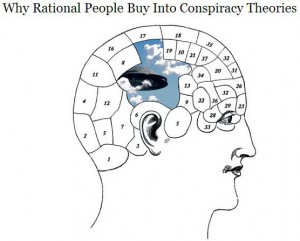Like most of the corporate media, the New York Times has been largely AWOL from investigations of disturbing events like the Boston bombing, 9/11, and Bush’s misleading the public into war. But it’s right out there on the front lines fighting against those who ask questions.. And the fighting is dirty.
 A huge story can set off alarm bells everywhere, but somehow, with ever increasing frequency, we note the silence of the mainstream media. Having avoided doing its job, it then protects its flank by denigrating those who call for inquiries.
A huge story can set off alarm bells everywhere, but somehow, with ever increasing frequency, we note the silence of the mainstream media. Having avoided doing its job, it then protects its flank by denigrating those who call for inquiries.
This Is Your Brain on CT
A recent example is this Times article : “Why Rational People Buy Into Conspiracy Theories.” It is illustrated with a Victorian diagram of the brain, updated to show the conspiracy theorist’s brain–with a flying saucer inside. The message is unmistakable: if you believe in any conspiracy (i.e., organized but deliberately hidden effort or operation) at all, you also believe in flying saucers carrying little green men.
The article reinforces this implication.
Here’s how it begins:
In the days following the bombings at the Boston Marathon, speculation online regarding the identity and motive of the unknown perpetrator or perpetrators was rampant. And once the Tsarnaev brothers were identified and the manhunt came to a close, the speculation didn’t cease. It took a new form. A sampling: Maybe the brothers Tsarnaev were just patsies, fall guys set up to take the heat for a mysterious Saudi with high-level connections; or maybe they were innocent, but instead of the Saudis, the actual bomber had acted on behalf of a rogue branch of our own government; or what if the Tsarnaevs were behind the attacks, but were secretly working for a larger organization?
Crazy as these theories are…..
The essay, by Times magazine columnist Maggie Koerth-Baker, implicitly suggests the public should immediately halt speculation once law enforcement officials “leak” information intended to shape our perceptions. No matter that these leaks are not the same thing as evidence presented at trial, that the leaks themselves serve an agenda, and that law enforcement has a long history of attempting to persuade the public of false narratives. No matter that the latter is a practice repeatedly, if often belatedly, chronicled by the Times itself.
Science Orders You: Stop Thinking Rationally
The author goes on to say that “recent scientific research” tells us that people who believe there’s more to a story may actually accept several competing theories as plausible. And because they are open to competing theories, they’re basically wacky. Such an ecumenical orientation to mysteries, akin to tolerating various conflicting religious faiths, is supposed to show that there’s something wrong with you.
However, another study might find that those who prefer pat explanations from the authorities are equally irrational.
For example, when the Tsarnaevs were first identified by the public from video footage released by the FBI, the Bureau told us the Tsarnaevs were previously unknown to it. Then the Bureau was forced by the Russians to admit it had known the brothers for quite some time. In fact, the Russians had briefed the Bureau on its concerns several years ago, and at that time, in response to the Russian information, the FBI had begun interacting with the Tsarnaev clan. This unexplained about-face was, according to establishmentarians, just fine. No questions, your honor.
Here’s another doozy. We were initially told that MIT police officer Sean Collier was killed in an altercation April 18 with the Tsarnaevs—perhaps at a convenience store. Later, the authorities said Collier was actually assassinated completely unaware—shot point blank in the head while sitting in his patrol car—at an odd spot in between buildings on the MIT campus—and by unknown assailants. This switcheroo was also A-OK with outfits like The Times. Nothing to investigate, no reason to be suspicious.
On April 19, the authorities told us that Dzhokhar Tsarnaev shot it out in a long gun battle with police before being apprehended. Later we learned, from the same authorities, that the young man, lying seriously wounded inside a boat parked in a suburban driveway, actually did not even have a gun with him. In fact, he was nearly executed in a totally one-sided gun battle. This fabulous flip-flop also raised no red flag with the establishment media.
On May 22 the authorities told us the FBI had to kill Tsarnaev’s acquaintance in Orlando, Florida, Ibragim Todashev, because he lunged with a knife and stabbed an agent several times. Later, it emerged that, well, maybe he didn’t have a knife at all, but maybe at some time he brandished a broomstick, or, at article press time, something else. And that was OK too, by gosh, for the journalistic glitterati.
Let’s face it: If a suspect in an interrogation room told this many contradictory stories, he or she would be locked up, and later probably prove eminently convictable by a jury. But a person who sees something sinister in such official confabulations gets lumped together with the people who see little green men from Mars floating in their soup.
Swami Says
Anyone who has ever written for outfits like the Times knows that sucking up to authority will always serve one well professionally. Consider the eagerly establishment-pleasing Koerth-Baker, a “science editor” who scrupulously follows the journalism-school rules of the road: She dredges up the perennial “academic” so that it appears that her reporting has no agenda—she’s just sharing what some “expert” thinks.
To prove what idiots her fellow Americans are, she turns to her expert, Dr. Viren Swami, a psychology researcher at a university which, we discovered, ranked 70th out of 106 UK universities on “research standards.”
Swami’s expertise to judge a large part of the population fantasists when it comes to security-state ops seems questionable. His doctorate is in “Body Size Ideals across Cultures”. His post-doctoral study was on “men and masculinities.” He has investigated such issues as “Why do hungry and stressed men idealize a heavier body size than do satiated and unstressed men?” and “the impact of body art (tattoos and piercings) on interpersonal perceptions.”
But more recently, he says, he’s been studying“why some people are more likely than others to accept and disseminate conspiracy theories.” Swami, in his picture, looks barely out of his twenties. Surely too young to remember all the security-service perfidy and cover-ups revealed by official investigations in both the United States and the UK. But Koerth-Baker assures us that Swami does include “conspiracy belief” in his many studies, and shares his wisdom with us:
“The best predictor of belief in a conspiracy theory is belief in other conspiracy theories,” says Viren Swami, a psychology professor who studies conspiracy belief at the University of Westminster in England. Psychologists say that’s because a conspiracy theory isn’t so much a response to a single event as it is an expression of an overarching worldview.
Turning the Eye Chart Upside Down
Koerth-Baker invokes a tired and overused Wikipedia-style meme from the late historian Richard Hofstadter on the “paranoid style” (also invoked by a rabid if purportedly liberal Los Angeles Times writer to dismiss a book by yours truly on connections between the Bush clan, their circle, and improperly understood American tragedies, while managing to ignore the book’s massive documentation—including more than a thousand footnotes). Koerth-Baker then says that:
Since Hofstadter’s book was published, our access to information has vastly improved, which you would think would have helped minimize such wild speculation. But according to recent scientific research on the matter, it most likely only serves to make theories more convincing to the public.
Perhaps that is because, of the many hundreds of books on the JFK assassination, about 95 percent of the best written and researched volumes, from credentialed academics, journalists and researchers, conclude that John F. Kennedy was not killed by a lone kook, but by real, powerful people who actively endorsed and sponsored overthrows and murders of elected leaders around the world, No matter. The author continues:
Perfectly sane minds possess an incredible capacity for developing narratives, and even some of the wildest conspiracy theories can be grounded in rational thinking, which makes them that much more pernicious. Consider this: 63 percent of registered American voters believe in at least one political conspiracy theory, according to a recent poll conducted by Fairleigh Dickinson University.
Her assumption is that, in a country perennially employing tens of thousands of top-secret covert operatives, homicide-trained assassins and “special forces” enthusiasts, no one has any reason to suspect that any event involving some kind of death or mayhem was ever engineered on an organized basis.
***
In 2010, Swami and a co-author summarized this research in The Psychologist, a scientific journal. They found, perhaps surprisingly, that believers are more likely to be cynical about the world in general and politics in particular. Conspiracy theories also seem to be more compelling to those with low self-worth, especially with regard to their sense of agency in the world at large. Conspiracy theories appear to be a way of reacting to uncertainty and powerlessness.
We are thus supposed to accept there is something essentially wrong with people who lose hope after seeing, time and time again, the most idealistic, reformist leaders inexplicably snuffed out, and their crusades dashed. This loss of hope and faith in a clearly dysfunctional system is seen as illness.
And, by the way, that article in “The Psychologist” (for which she provides no link or citation) was only three pages long.
Put the Blame on the Brain
“In these moments of powerlessness and uncertainty, a part of the brain called the amygdala kicks into action. Paul Whalen, a scientist at Dartmouth College who studies the amygdala, says the amygdala jump-starts the rest of the brain into analytical overdrive — prompting repeated reassessments of information in an attempt to create a coherent and understandable narrative, to understand what just happened, what threats still exist and what should be done now. This may be a useful way to understand how, writ large, the brain’s capacity for generating new narratives after shocking events can contribute to so much paranoia in this country.”
On the other hand, there is no mention of what part of the brain causes some people to reflexively–if illogically–trust just about anything published in establishment media like the New York Times, The Atlantic, or stated on PBS. Even after they get so very many things wrong time and again.
Avoid Knowledge!
Koerth-Baker invokes the “backfire effect” to explain why conspiracy theorists are supposedly resistant to official narratives. But that effort actually, well, backfires.
In 2006, the political scientists Brendan Nyhan and Jason Reifler identified a phenomenon called the ‘backfire effect.’ They showed that efforts to debunk inaccurate political information can leave people more convinced that false information is true than they would have been otherwise.
True, but the “inaccurate political information” being debunked was not a lunatic conspiracy theory–it was government disinformation, some of which was the product of conspiracy—for example, prewar disinformation that Iraq had WMD, or claims that tax cuts increase federal revenue. Refutation of these false assertions resulted in their reinforcement, the “backfire effect.” The authors suspect “Republicans might be especially prone to the backfire effect because conservatives may have more rigid views than liberals: Upon hearing a refutation, conservatives might ‘argue back’ against the refutation in their minds, thereby strengthening their belief in the misinformation.”
Koerth-Baker then tries to give Swami’s theories a piggyback ride on the work of Nyhan and Reifler:
“Nyhan isn’t sure why this happens, but it appears to be more prevalent when the bad information helps bolster a favored worldview or ideology.
In that way, Swami says, the Internet and other media have helped perpetuate paranoia. Not only does more exposure to these alternative narratives help engender belief in conspiracies, he says, but the Internet’s tendency toward tribalism helps reinforce misguided beliefs.
What worldview or ideology is held by Koerth-Baker and Swami? Is it bolstered by what they read in the New York Times?
Conspiracy Theories Approved By the Establishment
Koerth-Baker then quotes a historian at the University of California saying that conspiracies do exist. Don’t get too excited: she quickly supplies examples (Watergate, Iran Contra) where the conspirators were supposedly vanquished by an effective system in which the establishment media and Congress got to the bottom of things. In other words, don’t worry, everything is OK.
Except that a growing body of evidence indicates that the real conspiracy in Watergate wasn’t Nixon’s—but that of corporate and national security elements seeking to frame and force from office an uncooperative president. (If all you read is The New York Times, you wouldn’t know that there are at least three impressive best-sellers out there that make this argument persuasively.)
The point is that the establishment will always be consistent. By definition, if the goal is to prevent the public’s waking up to the degraded state of democracy, then the only “real” conspiracies we will be encouraged to worry about will be propagandistic constructions designed to send us off in hopelessly wrong directions. Thus, allowing the Republican establishment to create hysteria around a “socialistic, secretly Muslim president,” while the president and almost all other top officials are in the thrall of a real conspiracy by financial interests to dominate our system. Or vilifying an entire religion as bent on destroying our way of life to the point that we must give up our civil liberties for the protection of the state.
We recognize there is a kind of conspiracy fever in America, and that much of the speculation is groundless. But the authorities have brought this on with decades of deception, unnecessary secrecy, endless cover-ups and real crimes against the public interest. No wonder we can’t distinguish between plots on every corner and a skeptical attitude toward disturbing behavior from authority.
A Farrago
The beauty of Koerth-Baker’s article, published in the Times magazine where supposedly well-educated people get their ideas before going forth to repeat them at dinner parties and on talk shows, is that it is itself inherently irrational—the stuff of editorial and intellectual fogheadedness.
It take a very broad group of people who have little in common, and condemns them all, with the message that anyone who asks questions about official narratives should be considered delusional, albeit not necessarily clinically insane. The truth is, some people have been driven a bit, or more than a bit, crazy by repeated exposure to deeply disturbing real events (assassinations, mass murder, false-flag war-mongering), so that they begin to see a plot and a lie behind everything. This unfortunate strain of OTSD (On-going Traumatic Stress Disorder) is abetted by a substantial industry among radio, website and publishing personalities, who profit off the gullibility of their audiences by selling them bomb shelters and home canning equipment and other products of mass delusion.
But there is another group, to which we proudly belong: people who live in the real world and are not blind to nuance, people who don’t buy what the kook machines have to sell, but also recognize that the establishment media (compromised by, among other things, its financial dependency on the corporate elites) can’t be trusted to get to the real bottom of things.
To lump these different groups together and tar them all with the same brush amounts to a kind of willful journalistic malpractice.
By definition, an analysis involves the separation of a whole into its component parts. Rather than separating this complex subject into its parts, Koerth-Baker, Swami, et al do just the opposite. What they have created is a farrago which is, according to Mr. Webster, a confused mixture, a hodgepodge – as in, “a [farrago] of half-truths intended to put the party line in the best light.”
Along these lines, Koerth-Baker notes that ”Americans have always had the sneaking suspicion that somebody was out to get us — be it Freemasons, Catholics or communists.” No mention of the people that most people think are “out to get us” – members of the American aristocracy, without whom the New York Times would not even exist.
Fortunately, a bunch of articulate “nuts’ have challenged this Times piece. Guess who? Times readers. The response comments are full of thoughtful rebuttals. (By the way, we think New York Times readers who abhor that kind of manipulation would welcome the work we do at WhoWhatWhy but perhaps have not heard of our site. When you post intelligent, measured comments over on the Times site, feel free to mention and link to us.)
A Simple Solution
In order to understand who is a crazy conspiracy theorist, you first have to understand which theories are crazy, and which are valid—and that requires a knowledge of current events and history apparently beyond the ken of the likes of Koerth-Baker. Without such knowledge, you’re in no position to assess whether a perceived conspiracy might be real or not. Example: if you don’t know that John Wilkes Booth had accomplices in the death of Abraham Lincoln, you would judge as bonkers a statement that at least one American president was in fact killed by a conspiracy.
It is not clear whether Koerth-Baker is truly ignorant of these issues—or just wants to help the New York Times keep you ignorant. In any case, when it comes to understanding how the powerful stay powerful, we clearly need fewer critiques of members of the public who ask questions—and a lot more studies of the facts themselves.
[box]WhoWhatWhy plans to continue doing this kind of groundbreaking original reporting. You can count on it. But can we count on you? We cannot do our work without your support.
Please click here to donate; it’s tax deductible. And it packs a punch.[/box]
GRAPHIC: https://graphics8.nytimes.com/images/2013/05/26/magazine/26eureka/26eureka-articleLarge.jpg



